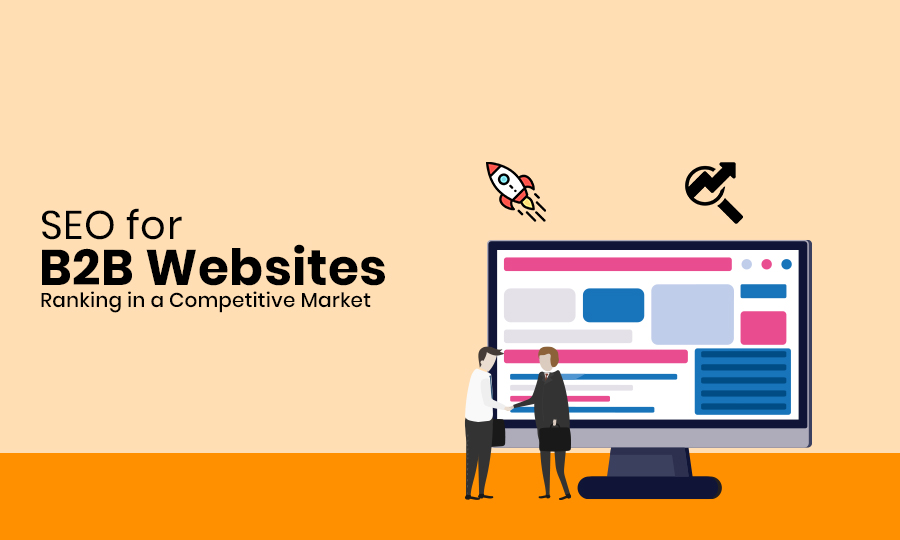The global business-to-business (B2B) e-commerce market was valued at USD 18,665.95 billion in 2023. It’s expected to be worth USD 57,578.97 billion by 2030, after growing at a rate of 18.2% per year from 2024 to 2030. The global market for business-to-business (B2B) e-commerce is continuously changing, and businesses must adapt to new technologies to survive. Nowadays, the majority of decision-makers conduct their research online before making purchases, so having a strong online presence is important. That’s why you need a website that showcases all your business’s products and services. But without proper implementation of search engine optimization, your website may not be easily discoverable by potential customers. To achieve this, you need a B2B SEO strategy to ensure your website ranks high in search engine results.
However, a B2B SEO strategy requires a perfect search engine optimization technique. In this article, you will get to know each step of the B2B SEO technique, including keyword usage and high-quality link building, and how you can create content for web pages and maintain landing pages and service pages to improve search engine rankings.
What Is SEO for B2B Websites?
Business-to-business, or B2B, refers to companies that sell goods or services to other businesses rather than individual customers. When you optimize your business-to-business site to rank higher on search engines, attract qualified leads, and establish brand authority, this process is known as a B2B SEO strategy. B2C isn’t as focused on a long sales funnel and many decision-makers. From SaaS companies like HubSpot to CRM tools like Salesforce, B2B companies are going digital more and more. To reach decision-makers, it’s important for businesses to be visible online and use SEO strategies. The sales funnel for B2B is more complex than for B2C, often involving multiple stakeholders in the decision-making process.
B2B SEO vs B2C SEO differences
| Factor | B2B SEO | B2C SEO |
| Target Audience | Focuses on business decision-makers, managers, and professionals. Example: SaaS companies promoting CRM software to other companies. | Focuses on individual consumers looking for personal products or services. |
| Buyer Personas | Multiple buyer personas (C-Suite, managers, IT teams) are involved in purchase decisions. SEO content must address all. | Usually, one main persona (the end customer) has faster decision-making. |
| Search Intent | Keywords are informational and solution-driven (e.g., “best CRM software for enterprises,” “B2B SEO strategy for SaaS companies”). | Keywords are more transactional and product-driven (e.g., “buy running shoes online”). |
| Content Type | Emphasis on in-depth, educational content like whitepapers, case studies, and thought leadership blogs. Builds trust for big investments. | Emphasis on short, engaging content like product descriptions, videos, and reviews. |
| Sales Cycle | Long and complex sales funnel – SEO must nurture leads with useful content and trust signals. | Short sales funnel – quick conversions, discounts, and emotional triggers work well. |
| SEO Strategy | A strong B2B SEO strategy requires keyword strategy, publishing expert blogs, and demonstrating ROI. SaaS companies use SEO to improve search rankings. | B2C SEO focuses on high-volume keywords, emotional appeal, and seasonal promotions to drive traffic fast. |
| Conversion Goal | Goal is to generate qualified leads (demo requests, free trials for SaaS, CRM software signups). | Goal is to drive immediate purchases (add to cart, checkout). |
Who Is the Target Audience for B2B SEO?
You need to identify the right audience to expand your business. Without knowing who you’re making products or services for, how can you deal with business? So, this is a critical element of any B2B SEO strategy. B2B SEO targets decision-makers who influence company purchases, unlike B2C, which focuses on quick sales. The target audience includes:
- Buyer Personas: You can develop thorough buyer personas, which help in the definition of positions such as managers, IT departments, and CEOs.
- Decision-Makers: These are the people who assess products like CRM platforms and SaaS tools.
- Users Interact With Content: Before contacting any vendors, your potential customers will read blogs, case studies, and white papers.
- User Pain Points: SEO content must address specific factors like cost-efficacy, productivity, or expansion solutions.
- Researchers and Influencers: Employees who investigate possibilities and make suggestions to management.
Moreover, you can target what your user need and integrate them with targeted content, so that businesses can ensure their SEO efforts can convert the right audience properly.
Why Is SEO Crucial for B2B Businesses Today?
- Promote Genuine Organic Traffic- For B2B companies, search engine optimization (SEO) is a significant part of digital growth. 60% of B2B buyers start their journey with online research. While 90% of B2B buyers find new suppliers online, only 17% spend time with potential suppliers. That’s why you need a strong B2B SEO strategy to improve brand exposure, authority, and persistent business growth. This means ranking higher in search engine results pages (SERPs) is important for exposure and business expansion.
- Reaching the Right Target Audience- A strong B2B SEO strategy revolves around search intent, pain points of your target audience, and long-tail keywords to make sure you connect with your ideal client and several buyer personas. Moreover, you can create high-quality content like blog posts, cluster pages, and service pages with relevant keywords, which helps users interact and move quickly down the sales funnel. A cluster page in B2B SEO is a detailed page that links to related subtopics around a main pillar topic. It will improve search rankings, internal links, and user engagement.
- Develop Authority and Legitimacy- SEO builds on itself over time, unlike paid ads. Ads stop running when the money runs out, but on-page SEO (title tags, meta descriptions, internal links), technical SEO checks (page speed, XML sitemaps, broken links), and building links from trustworthy sites all help your search engine results in the long term. Digital PR, content marketing, and blogging on industry blogs help establish oneself as a reliable leader.
What is the Best B2B SEO Strategy to Rank Higher in Search Results?
Successful B2B SEO requires an understanding of search intent. When someone looks up “best CRM software”, they are doing research. They’re one step closer to choosing when they look for “CRM implementation services”. Therefore, your B2B SEO strategy must address both scenarios through targeted content.
To develop a B2B website,it is necessary to implement the right SEO strategy. So,here you get a complete guide to B2B SEO strategy. So let’s delve deeper into the search engine optimization tactics to improve your online presence.
- How To Conduct Keyword Research for the B2B Industry?
In my list to improve your online visibility, the first step is to find relevant keywords for your B2B website. You need to target keywords that your potential customers frequently search for.
When users type specific terms on search engines, those are known as ‘keywords’. So you need to find out those keywords, then add them to your website content, headings, and so on.
Generate Keyword Ideas
You can use Google autocomplete to conduct the initial keyword research. You can put your main keywords in the search bar and let the ideas come up, like this:
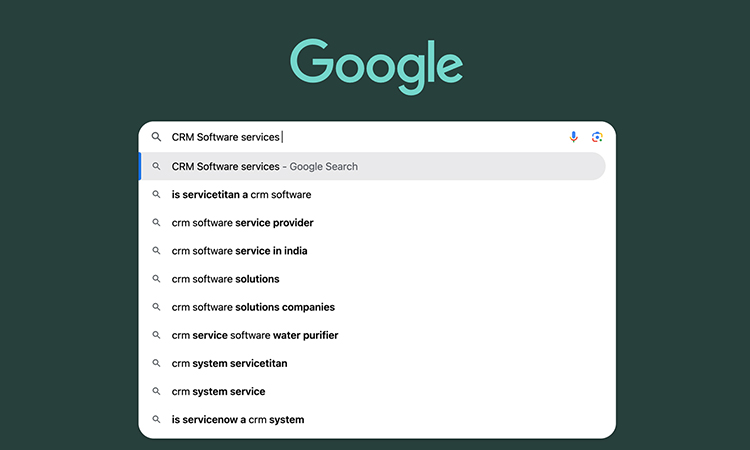
Best Keyword Research Tools For B2B SEO
- Semrush – all-in-one SEO tool for keyword research, competition, and content ideas.
- Ahrefs – excellent for backlink and competitive keyword analysis.
- Google Keyword Planner – a free tool to analyse search queries and search volume.
- Moz Keyword Explorer – good for finding keyword performance and intent metrics.
- Ubersuggest – beginner-friendly tool for quick keyword ideas.
Step-by-Step Guide To Researching Keywords Using Semrush
- Open Semrush Keyword Magic Tool
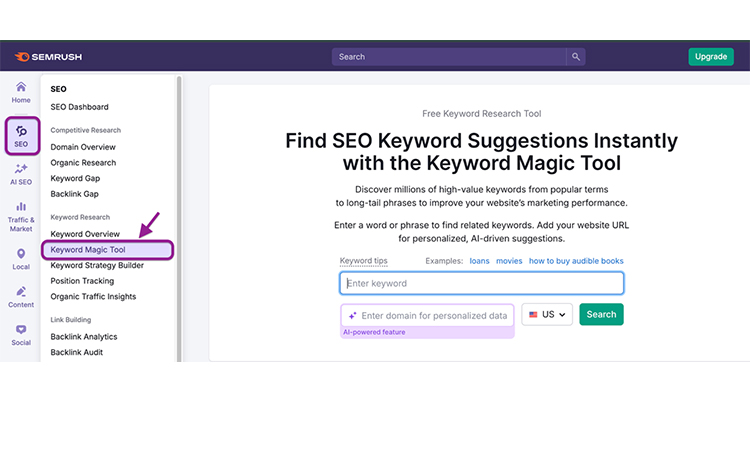
- Log in to SEMrush and go to the Keyword Magic Tool. This is where you’ll find a big list of new keyword ideas.
- Enter a Seed Keyword
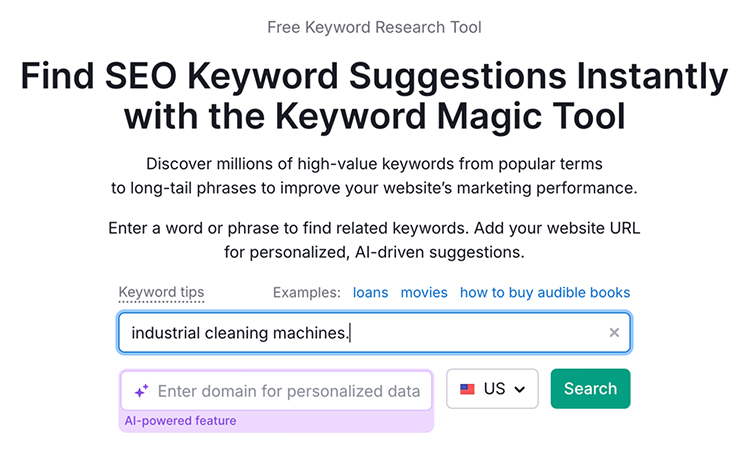
- Start with one broad keyword related to your business.
- Example: If you sell industrial cleaning machines to other businesses, type in “industrial cleaning machines”.
- Filter by Search Intent
When someone enters a query or keyword into a search engine, they are doing so with search intent. It shows what the user wants whether to learn something, compare options, or buy a service. It’s important for B2B companies to know what people are looking for when they search because decision-makers look for solutions. They can improve organic traffic, attract the right audience, and increase leads.
Semrush lets you sort results by what people want:
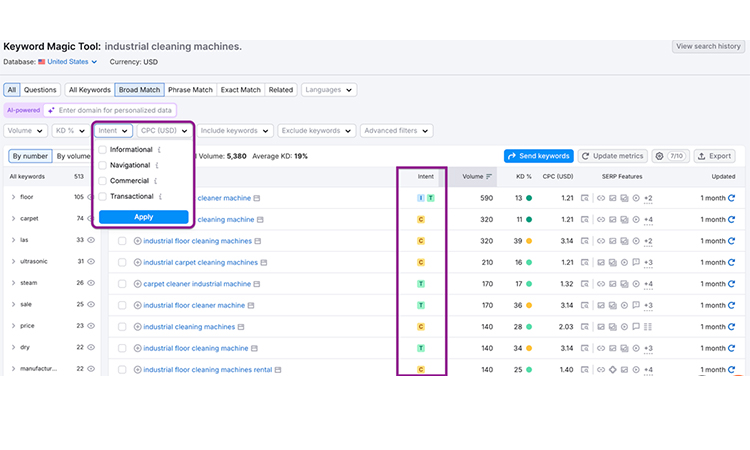
- Informational → People looking to learn (e.g., “how industrial cleaning machines work”).
- Transactional → People ready to buy (e.g., “industrial cleaning machines price”).
- Navigational → People searching for a brand (e.g., “Nilfisk cleaning machines”).
- Analyze Search Volume & Difficulty
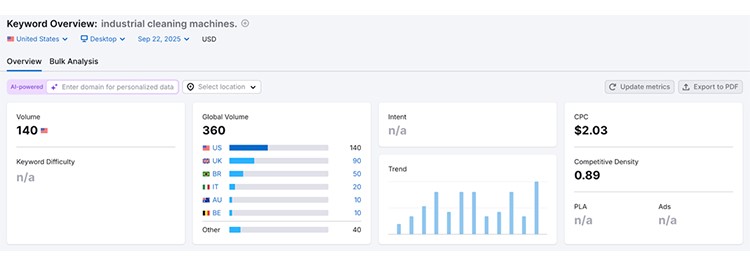
| Metric | What It Means | Why It’s Important For B2B SEO | Example |
| Search Volume | The number of times a keyword is searched in a month on search engines. It is known as search volume. | Shows how many potential leads are looking for that topic. | “CRM software for small business” → 1,200 searches/month |
| Keyword Difficulty | How hard is it to rank on the first page for a keyword? | Helps you prioritize keywords you can realistically rank for. | A difficulty score of 75/100 is very competitive. |
| CPC (Cost Per Click) | How much advertisers pay for a single click on this keyword in paid ads. | Indicates the commercial value of a keyword. High CPC often means high buyer intent. | “B2B SaaS solutions” → $15 per click |
| Competitive Density | The level of competition among advertisers bidding on the keyword in paid search. | Helps evaluate if the keyword is crowded for paid campaigns and SEO focus. | High density = many companies target this keyword. |
- Pick The Best Keywords
- You need to target keywords that match your target audience and business goals.
- Example: If you want more sales, target transactional keywords like – “bulk industrial cleaning machines supplier.”
- Export & Group Keywords into Clusters
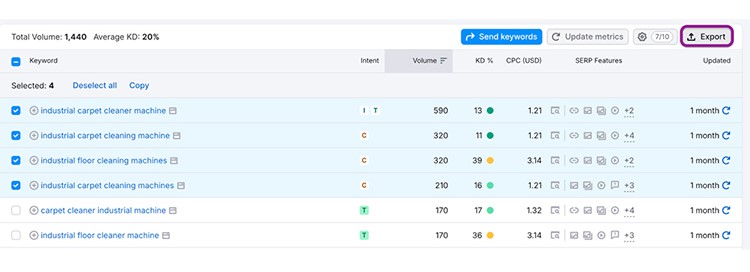
This way, you can develop content that answers different types of search queries, increase organic search, and fit naturally into your sales funnel.
- Check Your Existing Keyword Rankings
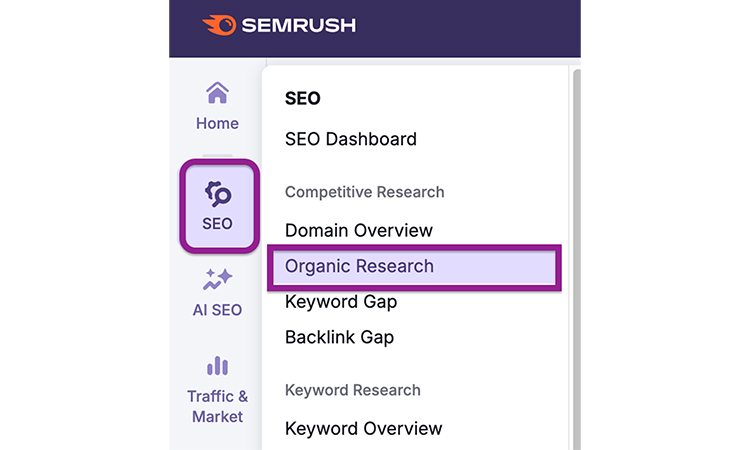
You can analyse your already ranked keywords with the help of the Organic Research Tool of Semrush.
Then you can put in your domain and go to “Position“, it will show keywords you rank for and where you stand in the rankings (as of the date at the top).
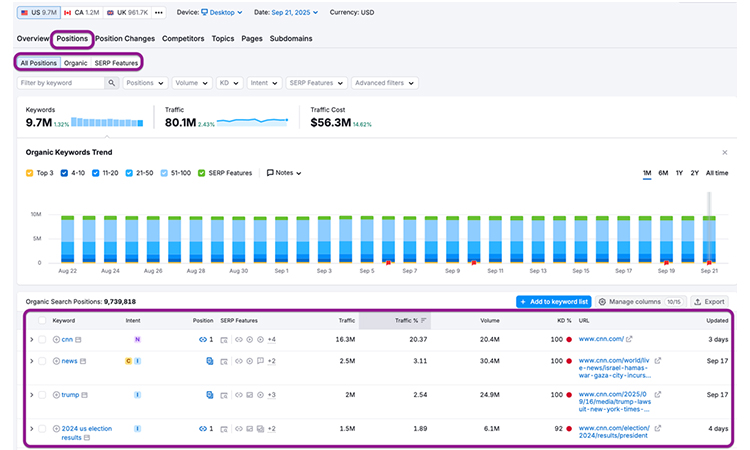
How To Stay Ahead Of Your Competitors In Keyword Research?
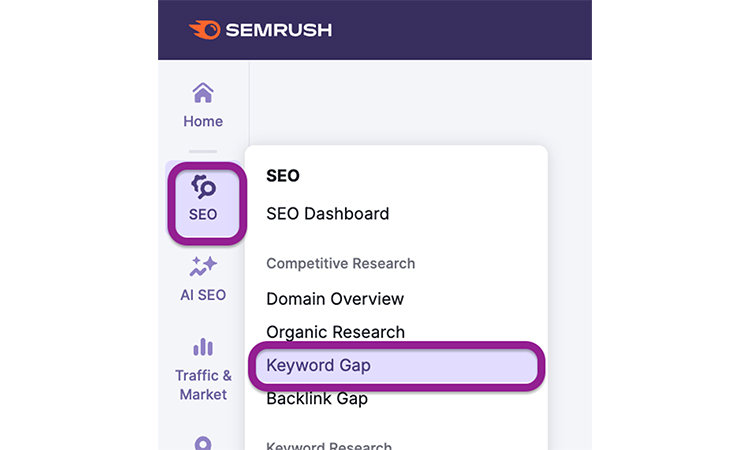
Go to Keyword Gap and put your own domain and your rival’s domain, like this –
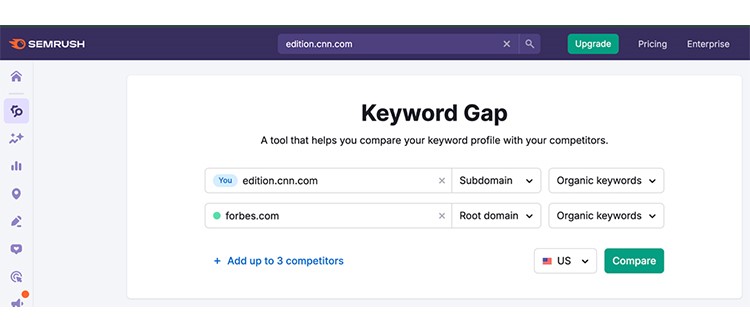
This shows you the keywords that your competitors rank for, but not you. So you need to input those keywords into your content.

Click on “Missing” in the table of terms that you found.
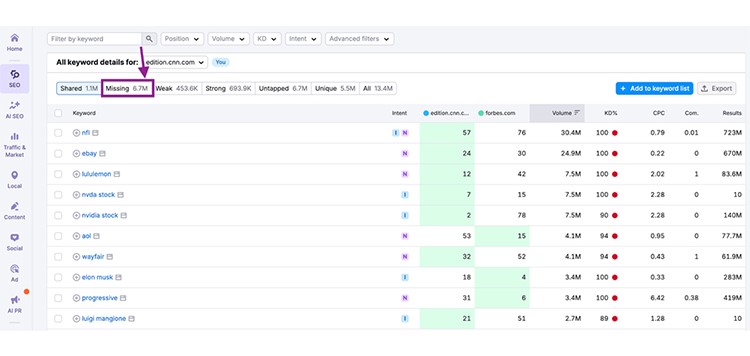
Keyword Research Tips for B2B Businesses
- You need to focus on long-tail keywords to improve search rankings.
- Use Google Autocomplete and Google’s AI Overviews for fresh keyword ideas.
- Then you can analyse competitors’ SEO strategies to uncover missed opportunities.
- You have to target keywords with high intent instead of only high search volume.
- Furthermore, you can create a content strategy around cluster topics and web pages.
- What Is the Content Marketing Strategy That Ranks and Converts B2B Buyers?
B2B content marketing needs a strategic approach that balances search engine optimization with conversion-focused messaging. 91% of B2B marketing managers say content marketing is an important part of their overall B2B SEO strategy. You need to create valuable content for your target market to increase organic traffic.
Google EEAT Content in B2B Marketing
Google EEAT stands for Experience, Expertise, Authoritativeness, and Trustworthiness. This framework helps Google decide if your content deserves to be high up in search results.
EEAT is important to B2B companies because, before investing money in services like CRM software or SaaS platforms, decision-makers look to trustworthy, data-supported content.
- Experience—Share real-world case studies, user pain points, and results.
- Expertise—Publish educational blogs, white papers, and industry insights.
- Authoritativeness—Earn backlinks from reputable sites and industry blogs.
- Trustworthiness—Add author bios, company details, service pages, and verified sources.
Develop Long-Form Content That Dominates Search Results
- Long-form content frequently surpasses shorter pieces in search results and user engagement metrics. Your keyword strategy needs to be perfect to create valuable content.B2B buyers like comprehensive resources that address their complex challenges thoroughly. Moreover, ultimate guides are highly effective for B2B content marketing because they serve as comprehensive resources for readers.
- When you create content, look for in-depth guides that provide genuine value. Generally speaking, a 3,000-word guide on the “Complete B2B Lead Generation Framework” will rank higher and produce more qualified leads than several shorter blog posts that cover superficial subjects. You need to include long-tail keywords to satisfy search queries.
- You can create content with pillar topics that complement your corporate objectives. Blogs should offer insights and educational resources that empower B2B buyers and establish the brand as a thought leader.
- Every article should focus on the main keywords and organically include related terms to raise keyword rankings for a variety of search queries. Shoulder topics are relevant themes that are indirectly related to your main product and can attract a wider audience.
Design a Data-Driven Content Strategy
Your content strategy has to meet the requirements of both SEO and buyers. So the first thing you can do is look at how well your current content is doing to see what your audience likes and what attracts organic search traffic. So, keyword research is necessary to find the perfect search volume and search intent of your target market.
Map content topics to different stages of the buyer journey:
- Awareness Stage: Educational blog posts addressing industry difficulties
- Consideration Stage: Comparison guides and solution overviews
- Decision Stage: Case studies, ROI calculators, and executing guides
Use of Long Tail Keywords for B2B SEO Success
Long-tail keywords are specifically valuable in B2B marketing because they express specific buyer intent with lower competition. So, you can search for “marketing automation for SaaS companies with less than 50 employees” instead of “marketing automation”.
These specific keyword strategies may not get as many searches, but the traffic they do get is more likely to convert because it is highly qualified. Long-tail keyword optimization is important for getting ready-to-buy prospects because B2B buyers often use detailed search queries to look for solutions.
You need to apply these keywords naturally throughout your content, especially headlines, subheadings, and meta descriptions. This approach enhanced both search visibility and user interaction.
Create Valuable Content That Increases Awareness
Valuable content goes beyond keyword optimization to address real business challenges your prospects face. Businesses need proof that you know about their line of work, their problems, and how they make decisions.
Develop content that demonstrates expertise through:
- Original research and industry opinions
- You need to employ detailed case studies showing realizable results.
- Step-by-step implementation guides
- Tools and templates prospects can use immediately
Improve User Engagement Through Interactive Elements
User engagement indicators help search engines determine content quality and relevance. B2B content should have different elements that keep your ideal customers interested for longer and encourage them to interact with it.
Include interactive components like
- ROI calculators and assessment tools
- Downloadable resources and checklists
- Video demonstrations and webinars
- Comment sections encouraging discussion
These elements increase time on page and reduce bounce rates, positive signals that can improve search rankings over time.
Optimize Blog Posts for Both Ranking and Conversion
Every blog post should serve dual purposes: ranking in organic search and moving prospects toward conversion. So, you should organize your posts with clear headings that include your target keywords and lead readers through a logical flow.
Include conversion elements strategically throughout longer pieces:
- Relevant resource offers in context
- Strategic internal links to service pages
- Clear calls to action that provide value
- Author credentials establishing expertise
This approach ensures your content works harder by both attracting organic traffic and converting visitors into leads.
Email Marketing as a Helpful Tool for B2B Content Marketing
According to 81% of B2B marketers, their preferred method of content marketing is email newsletters.
Email marketing is one of the most successful channels for B2B SEO campaigns because:
- It helps you stay in contact with your ideal customers at every stage of the sales process.
- You can include customized emails to tackle user pain points and guide buyers to solutions.
- Email newsletters share blog posts, case studies, and product updates that connect with your B2B SEO strategy.
- Marketing managers can monitor ROI, engagement, and conversions with the support of automated workflows.
Measure Your Content Marketing Success
You can monitor both SEO metrics and business results to keep improving your content strategy. So you must keep an eye on keyword rankings for target keywords and track how content creation improves leads and generates loyal customers. Updating outdated content can positively impact technical SEO by signaling freshness to search engines.
Key metrics include:
- Organic search traffic growth.
- Time on page and engagement rates.
- Lead generation from content offers.
- Content creation influenced the chain of value.
- Page Speed and Core Web Vitals Optimization
Your B2B website has to be loaded within 3 seconds. Page speed is an important factor in both technical SEO and user experience.
Google checks three important factors that affect how well a website works and how happy its users are. Most of the reputable sites maintain these ranking factors to improve their website loading speed.
What Are Core Web Vitals Metrics?
Core Web Vitals are critical metrics for assessing user experience and technical SEO.
- Largest Contentful Paint (LCP) quantifies loading performance. It should take about 2.5 seconds for your main information to load.
- First Input Delay (FID) measures the time between when a user types something and when the computer responds. Cut down on the amount of JavaScript that is run, get rid of code that isn’t being used, and delay scripts that aren’t needed to keep FID below 100 milliseconds.
- Cumulative Layout Shift (CLS) tracks visual security, removing unexpected content movement. Set the size of images, leave room for ads, and don’t add dynamic content on top of current content to keep CLS below 0.1.
You can take help from these primary tools to monetise page speed
- Google PageSpeed Insights
- GTmetrix
- WebPageTest
- Chrome DevTools Lighthouse
Implementation Example:
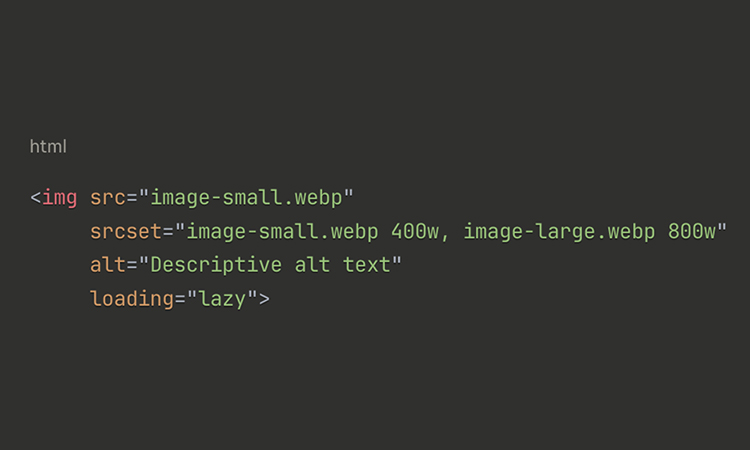
Server Response Optimization
- Manage your database –
- Optimize database queries
- Implement proper indexing
- Clean up unnecessary data
- Use database caching
- Caching Implementation:
- Enable browser caching with proper headers
- Implement server-side caching (Redis, Memcached)
- Use Content Delivery Network (CDN)
- Set up page caching for static content
- Server Configuration:
- Enable Gzip compression
- Minimize server response time
- Optimize server resources
- Use HTTP/2 protocol
- Website Should Be Mobile Friendly
Globally, most website traffic comes from mobile devices. Estimates range from around 60% to over 63%, but this can change by region and website type. More than two-thirds of web users access the internet through their phones as of mid-2025. This is the most common way for people to access the internet. This is the most significant way to improve technical B2B SEO.
Tips For Creating a Mobile-Friendly Website
- Design for thumb navigation
- Enhance form fields for mobile entry.
- Ensure buttons are at least 44 px in size.
- Implement mobile-specific features (click-to-call).
- Improve its performance with slower cell connections.
Specific Mobile Optimizations for Mobile Page Speed:
- Reduce server response time.
- Optimize images for mobile screens.
- Minimize JavaScript execution
- Use browser caching effectively
- Develop Accelerated Mobile Pages (AMP) if required.
Testing Methods:
- Use Google’s Mobile-Friendly Test
- Test on actual devices
- Check Chrome DevTools device simulation
- Verify touch targets are appropriately sized
Common Issues:
- Text too small to read
- If your content is wider than the mobile screen. It can create an adjustable issue on mobile screens.
- Touch elements are too close together
- Slow loading on mobile networks
- Image Optimization
You need to maintain your image size so that the website loads quickly and maintains professionalism.
Optimization Process:
- You can compress images using tools like TinyPNG or ImageOptim.
- Then convert to modern formats (WebP, AVIF).
- Develop responsive images with the expand characteristic.
- Add proper alt text for accessibility and SEO.
- Use lazy loading for below-the-fold images.
- Website Crawling and Indexing Analysis
When your user crawls your website, you need to maintain a few factors to improve user experience. Here, I discuss some important factors to enhance your website’s technical SEO audit.
Step 1: Check Robots.txt File
Optimizing your robots.txt file guides search engines on how to crawl your site. You can access it by visiting yoursite.com/robots.txt.
- Audit Process:
- Verify the file exists and is accessible
- Check for accidental blocking of important pages
- Ensure CSS and JavaScript files aren’t blocked
- Look for a proper sitemap declaration
- Common Issues:
- Blocking entire sections accidentally with “Disallow: /”
- Missing sitemap reference
- Blocking important resources like stylesheets
- Optimization Steps:
- Remove unnecessary restrictions
- Add sitemap URL: “Sitemap: https://yoursite.com/sitemap.xml”
- Test changes using Google Search Console’s robots.txt tester
Step 2: XML Sitemap Optimization
XML sitemaps help search engines discover and understand your website structure.
- Audit Checklist:
- Verify sitemap exists at yoursite.com/sitemap.xml
- Check for proper XML formatting
- Ensure all important pages are included
- Verify no broken or redirect URLs exist
- Confirm last modification dates are accurate
- Optimization Process:
- Generate a comprehensive sitemap, including all page types
- Split large sitemaps (over 50,000 URLs) into multiple files
- Submit to Google Search Console and Bing Webmaster Tools
- Set up automatic updates when content changes
- Include images and videos in specialised sitemaps
Step 3: URL Structure Analysis

URLs should be clear to improve both user experience and search engine understanding.
- Audit Elements:
- Check for overly long URLs (over 100 characters)
- Identify dynamic parameters and session IDs
- Look for non-descriptive URL patterns
- Find duplicate content caused by URL variations
- Optimization Steps:
- Implement descriptive, keyword-rich URLs
- Use hyphens instead of underscores
- Keep URLs under 100 characters
- Remove unnecessary parameters
- Set up proper URL canonicalization
- HTTPS and Security Implementation
HTTPS and security implementation refer to the use of an SSL certificate to encrypt a website. In B2B SEO, it increases trust, safeguards data, enhances search engine rankings, and assures businesses that their sensitive information is secure online.
Step 1: SSL Certificate Installation
Implementation Process:
- You need to get an SSL certificate from a trusted authority
- Install the certificate on the server
- Configure the server for HTTPS
- Update all links to HTTPS
- Set up automatic renewal
Step 2: HTTP to HTTPS Migration
- Migration Steps:
- Update internal links to HTTPS versions
- Implement 301 redirects from HTTP to HTTPS
- Update canonical tags to HTTPS versions
- Submit a new HTTPS sitemap
- Update Google Analytics and Search Console
- Common Pitfalls:
- Mixed content warnings
- Insecure links
- Third-party resources loading over HTTP
- Incorrect canonical tags
- Site Architecture and Internal Linking
Internal linking and site architecture refer to the arrangement and connectivity of web pages. In B2B SEO, they guide search engines and users to enhance navigation, raise rankings, share link equity, and promote a successful B2B SEO strategy.
Step 1: Site Structure Analysis
- Audit Elements:
- Check website hierarchy depth.
- Analyze navigation structure.
- Identify orphaned pages. Then remove those pages to create a more professional and elegant look.
- Review breadcrumb implementation. It will include a navigation track on web pages that helps users know where they are on a site.
- Optimization Goals:
- Keep important pages within 3 clicks from the homepage
- Implement logical category structure
- Create clear navigation paths
- Ensure proper breadcrumb trails
Step 2: Internal Linking Strategy
- Best Practices:
- Use descriptive anchor text
- Link to relevant, related content
- Distribute link equity throughout the site
- Create hub pages for important topics
- Implement related post sections
- Implementation Steps:
- Identify high-authority pages
- Create linking opportunities to important pages
- Use contextual internal links within content
- Implement automatic related content suggestions
- Moreover, you need to regularly audit and update the linking structure
- Duplicate Content and Canonicalization
When you have the same or very similar text on more than one web page, this is called duplicate content. Canonicalization helps search engines find the actual version of the content. In a B2B SEO strategy, it avoids ranking issues, enhances clarity, and increases authority for target keywords.
Step 1: Duplicate Content Identification
- Common Sources:
- URL parameters creating multiple versions
- WWW vs non-WWW versions
- HTTP vs HTTPS versions
- Trailing slash variations
- Print-friendly pages
- Detection Tools:
- Screaming Frog SEO Spider
- Google Search Console
- Copyscape
- Siteliner
Step 2: Canonical Tag Implementation
- Proper Implementation:
- Choose preferred URL version
- Add canonical tags to all duplicate pages
- Ensure self-referencing canonicals on original pages
- Update sitemap to include only canonical URLs
- Monitor for canonical errors in Search Console
- Example Implementation:
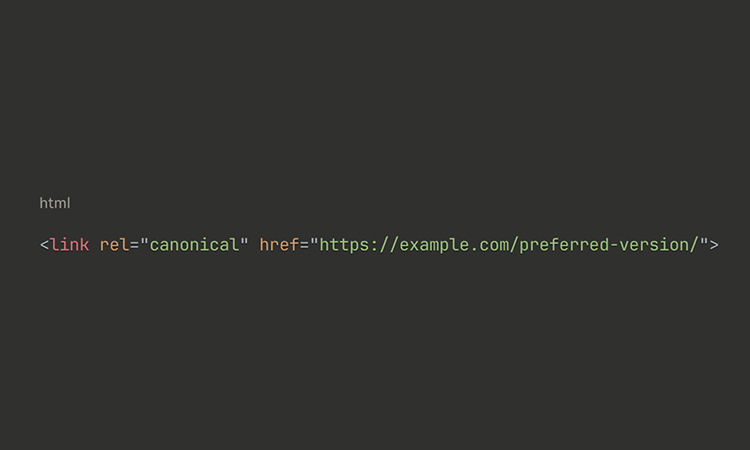
- Structured Data and Schema Markup
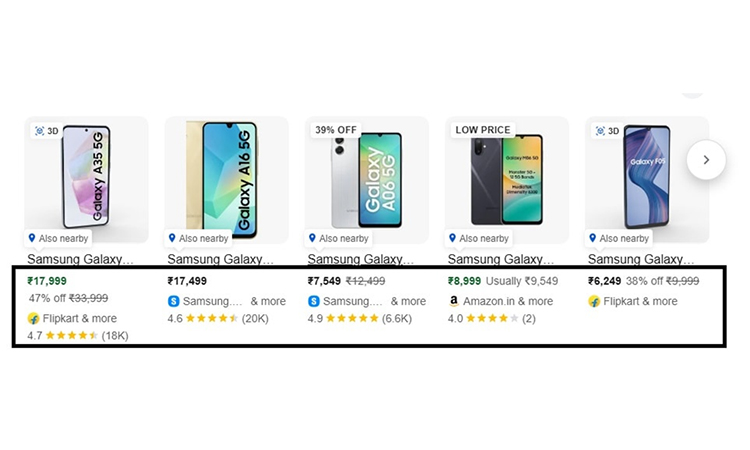
Structured data is code that is added to a website to help search engines better understand the meaning of its content.
Schema markup is the most common type of structured data, created by Schema.org.It provides context like product details, reviews, FAQs, or business information.
For B2B SEO, schema helps your pages appear with rich snippets (stars, FAQs, product details) on search engine results pages (SERPs), increasing click-through rates and organic traffic.
- Common Schema Types for Business:
- Organization markup
- LocalBusiness (if applicable)
- Article markup for blog posts
- Product markup for e-commerce
- FAQ schema for question pages
- Implementation Process:
- Choose appropriate schema types
- Implement JSON-LD format (recommended)
- Test markup using Google’s Rich Results Test
- Monitor rich snippets in search results
- Update schema as content changes
Rich Snippets Optimization
These are Google search results that show extra information like reviews, pictures, and costs. They are also known as “rich results”. These things can help get more people to visit and look at your website.
Google usually gets this information from structured data markup code in your HTML page.
Here’s an example of a rich snippet:

Well-optimized picture with ratings and price details. You can optimize these tactics to improve your online visibility.
- How to do Technical SEO Monitoring and Maintenance?
After implementing all technical SEO audits on your website, you need to monitor technical SEO efforts in the following way:
Step 1: Regular Monitoring Setup
Key SEO Tools to Check Technical SEO:
- Google Search Console for crawl errors
- Google Analytics for performance metrics
- Site monitoring tools for uptime- Pingdom, Site24x7, StatusCake, New Relic Synthetics
- Speed monitoring tools for performance: New Relic APM, Dareboost
Monthly Checklist:
- Check for crawl errors
- Monitor page speed metrics
- Review mobile usability reports
- Analyze Core Web Vitals data with appropriate SEO tools
- Check for security issues
Step 2: Continuous Optimization
Ongoing Tasks:
- Regular performance audits
- Update technical implementations
- Monitor algorithm changes
- Test new optimization techniques
- Keep software and plugins updated
Quarterly Reviews:
- Comprehensive technical audit
- Performance benchmark comparison
- Security vulnerability assessment
- Mobile optimization review
- Structured data accuracy check
- What Is the Essential B2B On-Page SEO Strategy?
B2B on-page SEO strategy is centred on improving individual web pages to rank higher in search engine results while targeting business decision-makers and procurement teams. B2B SEO must deal with longer sales intervals, multiple stakeholders, and intricate buying processes through strategic content and technical optimization.
Meta Title Optimization for B2B SEO
Meta titles are the first shown title of your webpage. It is visible on search engine result pages.
- Most importantly, you keep titles between 50 and 60 characters to prevent truncation.
- You need to place the primary keyword near the beginning.
- Include the brand name at the end (separated by a pipe | or dash -).
- Use action words that appeal to decision-makers.
Example of Optimized B2B Meta Titles:
- “Enterprise CRM Software Solutions | Increase Sales by 40% | CompanyName”
- “B2B Marketing Automation Platform for SaaS Companies | BrandName”
- “Manufacturing ERP Implementation Services | ROI-Focused | Service Provider”
B2B-Specific Title Elements
- Include industry-specific terminology
- Mention business benefits (ROI, efficiency, scalability)
- Reference company size or type when relevant
- Use power words like “enterprise”, “professional”, and “solution”
Meta Description
Meta descriptions are attributes in HTML that give short summaries of the content of a web page. They aren’t ranking factors for on-page SEO, but they affect search result click-through rates because they act as banners that redirect people to your page.
- The ideal meta description should be between 150-160 characters
- Write complete sentences that read naturally
- Avoid truncation by testing across different devices
- Then you need to include primary and secondary keywords naturally
- You can address specific business pain points
- Highlight quantifiable benefits and results
- Include social proof elements (client count, years in business)
- Mention industry expertise and certifications
- Use action-oriented language that encourages clicks
- Include phrases like “Learn how,” “Discover,” or “Get started.”
- Create urgency when appropriate (“Limited time,” “Free consultation”)
- Match the description to the page content accurately
Title Tag Best Practices and Implementation For B2B SEO
HTML Structure:

Dynamic Title Generation: You can follow these factors to optimize the title tag for B2B SEO
- You need to develop title templates for product/service categories
- Then you can add location data for local B2B services
- Incorporate pricing or offer information with relevant keywords
- Use customer data for personalized titles
Multilingual Considerations:
- Translate titles while maintaining keyword relevance
- Consider cultural differences in business communication
- Adapt character limits for different languages
- Implement hreflang tags for international targeting
Header Tag Structure and Optimization
Header tags (H1, H2, H3, H4, H5, H6) create a content structure that both users and search engines use to understand page organization and topic relevance.
H1 Tag Optimization:
- Use only one H1 per page
- Include the primary target keyword naturally
- Match H1 closely with the meta title
- Make it compelling for human readers
- Keep between 30-60 characters
B2B Header Tag Examples
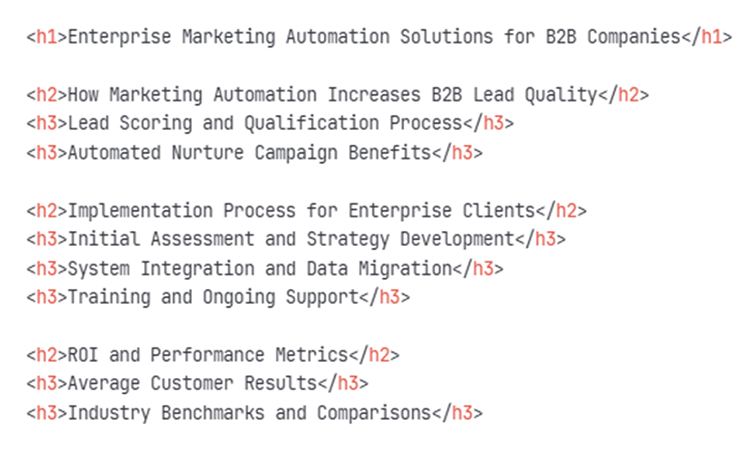
- How To Do Link Building for B2B Industries?
Link building for B2B industries needs a proactive approach that centers on developing relationships with authoritative domains. It will show genuine value to business audiences. A B2B SEO strategy requires high-quality backlinks from relevant, authoritative domains. This helps improve search engine rankings and generate targeted traffic to your website.
Digital PR
Digital PR forms the backbone of successful B2B link-building campaigns. You can write newsworthy content that trade magazines and websites will want to use and share with their readers.
Effective Digital PR Strategies:
- Original research: You can write reports on your industry that include unique data that reporters can use.
- Expert Commentary: You may present perspectives on industry trends to trade publications.
- Case Studies: Share detailed success stories that demonstrate measurable results.
- Thought Leadership: Contribute guest articles to respected industry blogs.
Example Sources: TechCrunch, Forbes Business Council, Harvard Business Review, and industry-specific publications like MarTech Today or Sales & Marketing Management.
Partner Pages and Business Relationships
You can take help from existing business relationships for natural link-building possibilities. Partner pages on client websites, vendor directories, and business association listings provide valuable backlinks from relevant sources.
Partnership Link Opportunities:
- Pages with customer reviews and company names
- Software platforms with vendor partner directories
- Chamber of Commerce and industry association member listings
- Supplier pages on enterprise client websites
Example Platforms: Salesforce AppExchange, HubSpot Partner Directory, Google Partner badges, and Microsoft Partner Network.
Advanced B2B Link Building Tactics
- Participating in industry events: You can give talks at conferences often leads to links to your speaker page and coverage of the event.
- HARO (Help a Reporter Out): You can respond to inquiries from reporters regarding your field of expertise.
- Broken Link Building: Then you need to identify broken links on industry websites and suggest your content as a replacement.
Measure Success with Key Performance Indicators
Track specific key performance indicators to measure your link-building effectiveness:
- Domain Authority Growth: You can observe growth in overall site authority.
- Referral Traffic Quality: Then you can analyze traffic from generated links.
- Keyword Rankings: This is very important in a B2B SEO strategy. You need to record improvements for target terms.
- Lead Generation: Measure leads attributed to link-building efforts.
- Social Media Marketing to Improve B2B SEO Strategy
84% of B2B buyers use social media marketing as part of their decision-making process. You need to create consistent, high-quality content paired with social engagement, which increases brand reputation and promotes B2B SEO campaigns. Moreover, you need to share content on platforms like LinkedIn, Twitter, and industry forums to help attract the target audience and promote your B2B SEO strategy.
- Share Valuable Content: First, you need to publish blog posts, case studies, white papers, and industry perspectives that tackle user pain points.
- Engage with Followers: Then you need to reply to comments, join discussions, and interact with buyer personas.
- Take Help From LinkedIn: Most importantly, you need to interact with decision-makers, share service pages, and participate in relevant groups.
Use Social Signals: Likes, shares, and comments can indirectly influence search engine rankings by increasing content reach.
- How to Do Local SEO for B2B Companies?
Local SEO for B2B businesses is highly effective in attracting local customers. This is the most significant and powerful B2B SEO strategy. You need to follow the following steps to implement the right local SEO tactics.
Google My Business Optimization for B2B
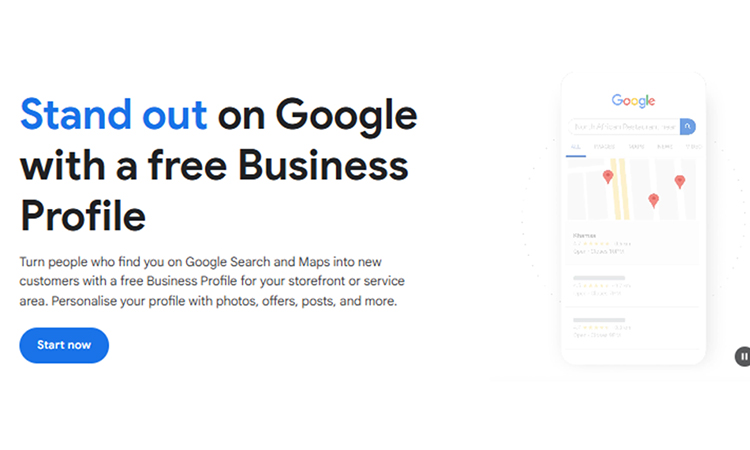
- Add Business Information
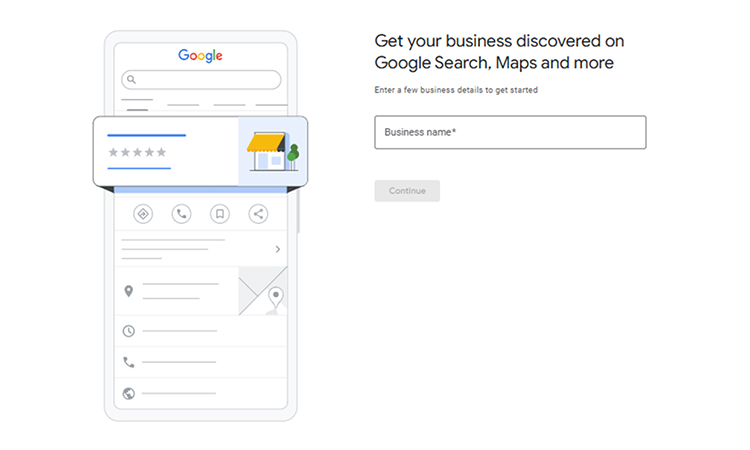
- Write a Compelling Description
- Then write a clear explanation of what your business does, who your ideal customer is, and how you solve issues faced by your customers.
- Then add relevant keywords naturally for SEO for B2B industries.
- Upload Visual Asset
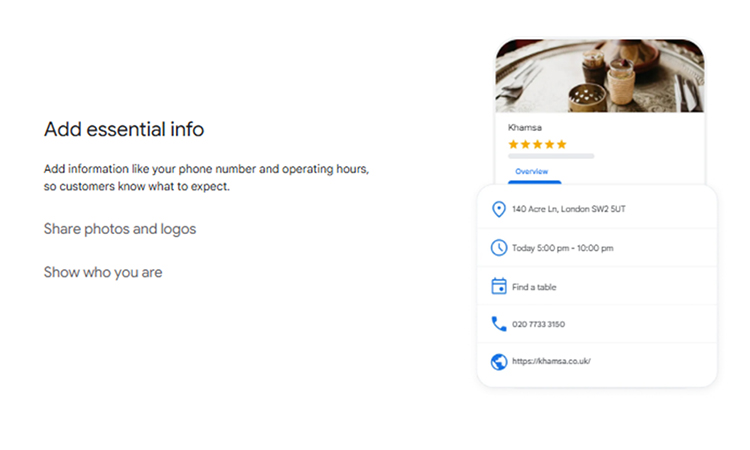
- Showcase Products or Services
- Moreover, you can create separate sections for service pages.
- Include descriptions, benefits, and CTAs for each offering.
- Add Social Proof and Links
- You can include reviews, testimonials, case studies, and certifications.
- Then you need to link your website, blog, and social media to enhance the authority of B2B SEO.
Local Keyword Strategy for B2B
- Geographic Keyword Research: You need to target location-specific keywords that B2B buyers use when searching for local solutions. It is very important in local SEO for B2B companies. So you need to target keywords like “Chicago B2B marketing agency”, “Dallas enterprise software consultants”, or “Boston manufacturing automation services”.
- Optimization of Service Areas: If you serve several cities or regions, you must optimize for larger service areas. Then you can create dedicated location pages for each major market you serve. To get better results, you can highlight local case studies and client testimonials.
- Industry-Specific Local Terms:Moreover, you have to incorporate industry keywords with location modifiers. Target phrases like “manufacturing ERP specialists near me” or “local SaaS implementation partners”.
B2B Landing Page Optimization
- Location-Specific Landing Pages: You can make particular pages with local company addresses, phone numbers, and content tailored to each geographic market. This will help establish reliability and confidence with potential partners.
- Local Business Schema Markup: Apply structured data markup, including LocalBusiness schema, address information, operating hours, and service area details. This helps search engines understand your local relevance.
- Contact Information Consistency: Your NAP (Name, Address, Phone) should be consistent across all online platforms, including your website, social media profiles, and business directories.
Local Citations Building to Improve Local SEO for B2B Industry
- Submissions to Local Business Directories: List your business in relevant local directories such as Yelp for Business, the Better Business Bureau (BBB), industry-specific directories, and regional business publications.
- Community Involvement: Then you can participate in local business events, sponsor community initiatives, and engage with local business networks. These events often generate natural local backlinks, and brand mentions to improve local SEO for B2B.
Client Reviews and Testimonials Management
- Review Generation Strategy: Furthermore, you can ask happy B2B customers to leave reviews on Google My Business, platforms that are specific to the industry, and professional review sites like G2 or Clutch.
- Optimizing Testimonials: Put client testimonials in a prominent place on pages that are specific to a location. Moreover, you can include the client’s company name and location with the testimonial.
Mobile and Voice Search Optimization
- Mobile-First Approach: You need to optimize for mobile users searching for “B2B services near me” or similar local queries. The contact forms should load flawlessly on mobile devices and tablets, and so on.
- Voice Search Optimization: Target conversational keywords that B2B buyers might use with voice assistants, such as “find business consultants in my area” or “who provides IT services locally.”
Frequently Asked Questions- B2B SEO Strategy
B2B SEO usually takes 6-12 months to show major results due to longer sales intervals and complex buyer journeys. SEO is a long-term process; it will surely give you the best results in the long run.
B2B SEO focuses on qualified organic traffic, keyword rankings for commercial terms, lead generation from organic search, conversion rates, and content engagement from target buyer personas.
B2B SEO costs range from $2,000 to $10,000+ monthly, depending on company size and competition. Small businesses pay $2,000-$5,000, while enterprise companies invest $10,000-$25,000+ monthly for comprehensive SEO strategies and faster results.
Let’s Wrap Up Our Comprehensive B2B SEO Strategy Overview
We are at the end of our conversion of the B2B SEO strategy, and I can assume you have all your queries resolved. So we discuss the top 15 most useful B2B SEO strategies to uplift your online presence.
Though you can run a successful SEO campaign on your own, if you take the time to work with an experienced SEO team, you can maximize your results and see even greater success. The SEO experts can create an exceptional SEO strategy for your B2B business that aligns with your specific goals and target audience.
So don’t wait too much; get an SEO expert to help and run your B2B SEO campaign and highly rank your website in a competitive market.


